#cunninghamia
Explore tagged Tumblr posts
Text

China Fir cones.
#trees#cunninghamia#china fir#evergreens#cupressaceae#cones#yet another conifer that isn’t at all what the common name would have us assume…#it ain’t in the fir family it’s in the cypress family#anywho the conifers in this particular park all bear cones at different times of year so i like to collect them for various uses#these i have soaking in grain alcohol for a perfume experiment 🔬
16 notes
·
View notes
Text
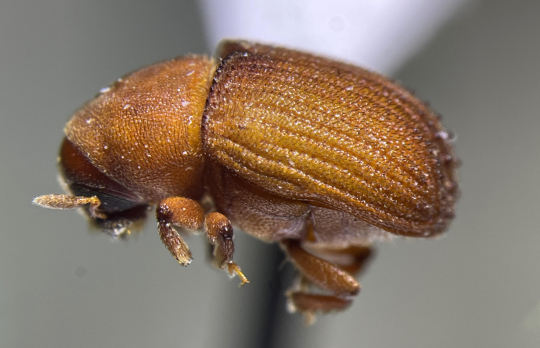
i recently solved a fun little bug mystery at work and i thought it might be interesting to write up a step-by-step narrative of how i did so, as a sort of example of the kinds of things i get to do for my job. this is a stupidly long post because i have no editorial self-control so i'm putting the rest under a cut.
the above insect is a bark beetle, one of a series of 6 specimens i found in a drawer at work. they did not have species labels on them, and the collection labels indicated that they were collected in 1997 from "Chinese Cedrus used for artifical christmas trees." the infested wood had been intercepted and the beetles collected and pinned, but whoever was working in the lab at the time wasn't able to suss out the species, which is extremely reasonable because even IDing american bark beetles to species can be a massive pain in the ass, let alone ones from asia.
the beetles were clearly in the genus Phloeosinus based on the shape of the antennae and the large spines on the elytral declivity (the ass area), and whoever pinned them at least got them that far themselves, but determining the actual species was going to be a lot harder. even american beetles in this genus can be devilishly hard to confidently ID to species since they often look alike and also are quite morphologically variable in ways the bleed into each other. they are pretty cool though and those ass spines are usually critical in species-level identification

btw since i'm going to be writing out this word a lot in this post, it's pronounced roughly as "flea-o-sign-us" if you're curious.
determining bark beetle species is often made much easier by knowing what tree the beetle came out of since most bark beetles (but not ambrosia beetles, which are also scolytid/scolytine beetles but a whole other can of worms grubs) are highly host-specific, usually being adapted to only a certain tree species or genus or small group of related genera.
so Cedrus is the genus for eurasian cedar trees, and there is one species of Cedrus native to china, Cedrus deodara, but that seems like an odd choice of plant to harvest and send to america for artificial christmas tree trunks. most actual Cedrus species are from the mediterranean area. however there are also some chinese trees in the cypress family Cupressaceae (+Taxodiaceae) that are called cedars, and in fact most species of Phloeosinus are exclusively found in trees in this family. one likely species is Cunninghamia lanceolata, traditionally called "chinese fir" despite not being a fir but also more recently marketed as "chinese cedar" because that's how common names for species go.
oh and there is also the tree Toona sinensis in the family Meliaceae that's ALSO sometimes called "chinese cedar" for some reason but more importantly also called "beef and onion plant" lmao, but that was an even worse candidate for an artificial christmas tree trunk and also not a known host for the beetles. easily discounted but i had a laugh.
so my first angle of attack was to assume that the collection labels were correct and the beetles were in fact from a Cedrus tree. i was able to find a list of about a half dozen Phloeosinus species known to attack Cedrus cedars, but none of them were native to china. this would most likely mean that one of the mediterranean species had been transplanted to china for cultivation, which is entirely plausible. after digging though a bunch of literature i wasn't able to find a good key for Phloeosinus species in the entire area i wanted, but found a couple regional keys covering geographic ranges that when combined covered about what i wanted. for non-biologists, this is what a species key looks like:

sort of a choose your own adventure kind of thing but for determining a creature's true identity. anyway none of the results i got from these keys led to species who's descriptions matched the one that i had. i should also mention that my specimens had a rather distinctive feature unlike any other Phloeosinus species i'd ever seen before, which was an elytral vestiture consisting of these really funky little black explanate scales:
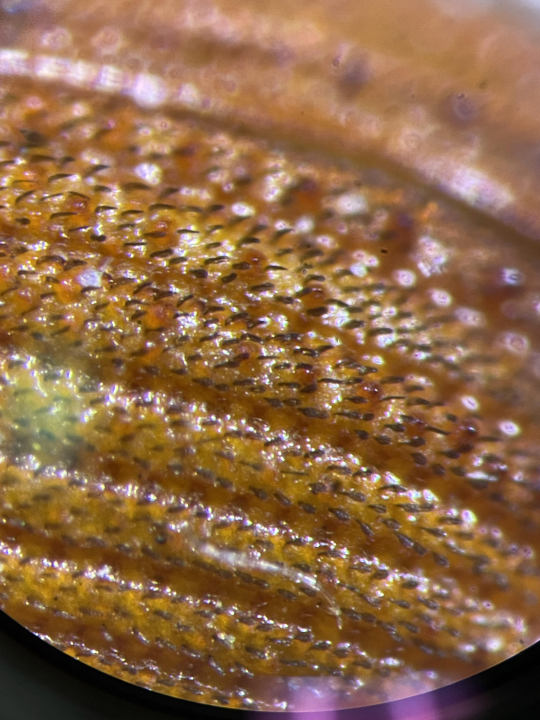

most Phloeosinus species have some kind of vestiture on their elytra but all the ones i'm familiar with have the hairs and scales light-colored and never shaped anything like this, so i figured that the description of the correct species would surely mention these scales.
so anyway dissatisfied with this avenue, i decided that the next most likely option is that whoever made the labels for the specimens was told that they had come from "chinese cedar" by the importer and had just assumed that meant Cedrus but it was actually one of the cypress family cedars. again most of the described species do in fact use Cupressaceae as hosts.
so next i found this UN report with a (hopefully) comprehensive list of all non-EU bark and ambrosia beetle species that attacked conifer trees. i culled from that a list of Phloeosinus species listed as coming from "asia." since that was too broad of an area, i then looked up all of these species in the species catalogues listed in the report, mostly Alonso-Zarazag et al (2007), though some were also listed in Wood and Bright (1992) or Bright and Skidmore (2002), which i happen to have physical copes of. from these i could narrow the list down to just species found in china.
now things became difficult because there are no keys to chinese Phloeosinus, or at least none in english. also even just written descriptions of many of these species were impossible to find because they were all written like 60-100 years ago and usually in chinese or german or french and had never been translated or uploaded anywhere online. likewise almost none of them had research-grade (or any) photos anywhere online.
so after hours of fruitless digging, the best i could come up with was a guide to scolytine beetles of korea (PDF link), which contained a key with a handful of the species on my list and did include english descriptions of these. now one of the species in the guide, P. perlatus, IS DESCRIBED as having dark scales, and my specimens did seem to land on that species when i ran them through the key. that's promising! and the hosts were on my list of possible non-Cedrus chinese cedars! also promising! buuuut something just didn't sit right with me. parts of the species description in that paper just didn't seem to quite match my specimens, like for example the size was a little off, described as being 2.4-3.4mm long, while all of mine were in the 3.3-3.6 range. plus the photos of the species, while distressingly low-resolution, just didn't look like mine.
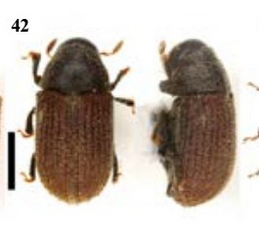
okay so that was dissatisfying. i'd managed to whittle down my list of suspects a good deal from what little scraps of information i could find about them through my sleuthing, either the wrong hosts or the ones that did have english descriptions available online like in that korean guide didn't fit, but i was still left with several possible candidates and no way to narrow it down further, of course this all assuming that the beetles i had on my hands even were a species that had been scientifically described and named. bark beetles are a huge group of critters and many are quite understudied, especially in asia, and a bunch of new species are described every year!
i was about ready to just give up, but then by coincidence i had a reason to email a couple of high-level bark beetle researchers about a different beetle mystery i was also working on, which was in a group that they were the authorities on. on a whim, i mentioned my Phloeosinus conundrum to them to see if they had any ideas and they recommended i contact Dr. Roger Beaver. yeah, i know right? fucking kickass name i'm so jealous. sidenote: it's so funny how many bark beetle researchers have extremely appropriate names, like two of the biggest names in the field are Steve Wood and Dave Wood. no relation.
so anyway i contacted Dr Beaver, who had done some research on east asian Phloeosinus in the past and he was kind enough to send me an unpublished provisional key to chinese species that he had written up a few years ago. using that key, i ended up at "P. pertuberculatus (?=sinensis)" which means that there was some suspicion that P. pertuberculatus and P. sinensis were the same species, just described and named independently by two different entomologists (Hans Eggers and Karl Eduard Schedl respectively), as often happened, especially in the glory days of insane 18th-20th century european entomologists describing literally thousands of new species during their careers.
now these two species WERE both on my final list of suspects of chinese Phloeosinus species that hadn't otherwise been eliminated for one reason or another, and both had Cunninghamia "cedar" trees as known hosts. Dr Beaver was then kind enough to scan and send me the original descriptions of these two species:
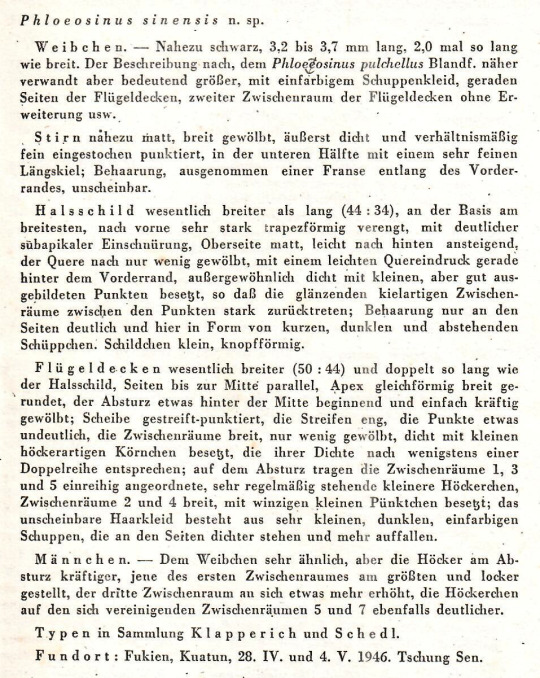
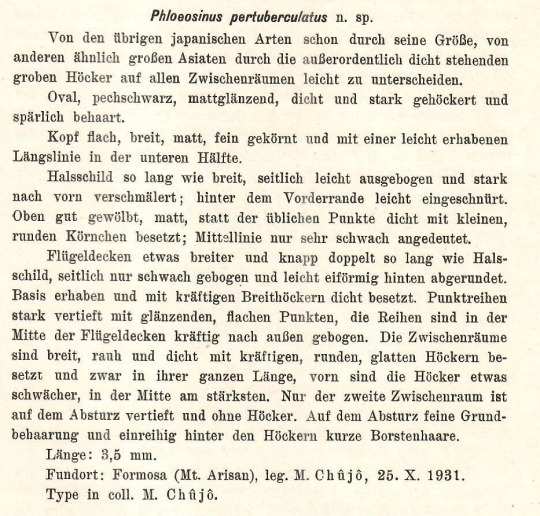
which i was able to use google translate on:
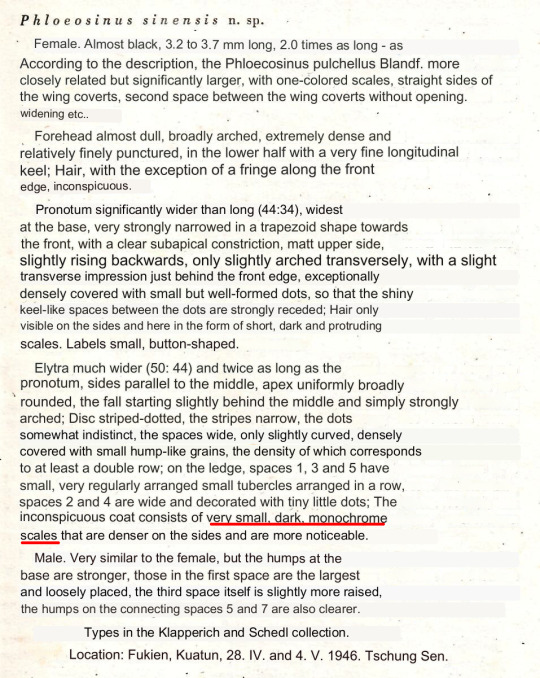
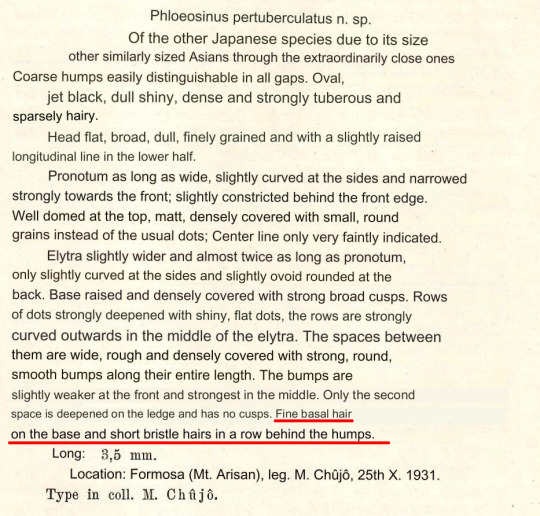
not the nicest translation but still an admirable attempt on google's part to deal with all the entomological jargon, and most importantly the description of the elytral scales on P. sinensis definitely seems to match my specimens more than the pertuberculatus. plus i found a paper on taiwanese bark beetles (PDF) coauthored by Dr Beaver that had a (also distressingly low-resolution) photo of pertuberculatus that didn't seem to match my specimens:

aaand finally: i'd been trying for days to access the webpage of a chinese museum that popped up as the only notable result on a google image search for P. sinensis but every time the website would time out and the cached version of the image was too small to make out any details on, but it finally occurred to me this evening that the reason was probably because my work computer or work wifi was just automatically blocking chinese websites because of america's insane paranoia about chinese spying, and sure enough i opened it up on my home computer and it fucking worked!
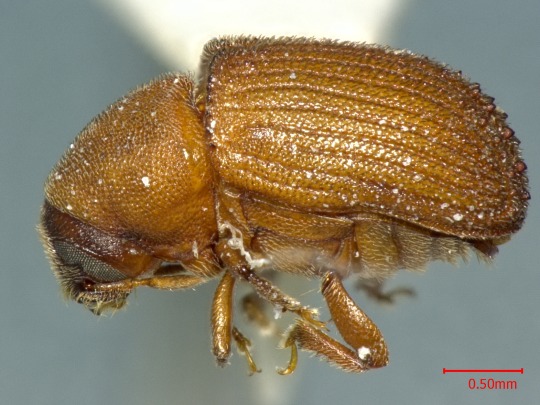

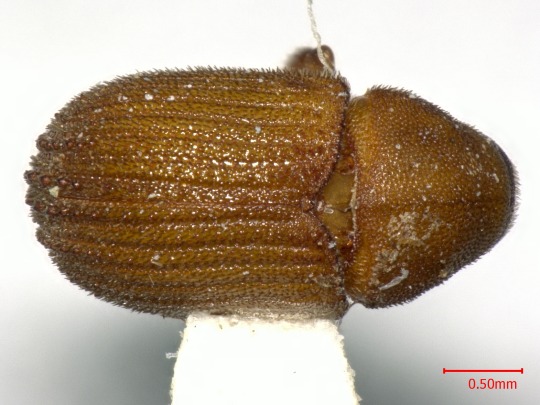
that's a pretty fucking bang-on match for my specimens! the scales look right, the color is right, the size is right, the ass bumps are right, the host is right, the geography is right, and the translated description otherwise seems to match! here's mine again so you don't have to scroll all the way up:

so i'm calling this 26-year mystery solved! not all of the bug puzzles i've worked on have had as meandering of a path to their conclusion as this, but i thought that this one did display a good number of the different methods i use. the biggest thing that was missing was me wandering into my lab's massive library of old dusty entomology journals stretching back over a century and digging out some old article that never got scanned and put online, as often happens, but in this case since the bugs were asian and out library mostly covers north american entomology that wasn't going to be very fruitful.
hopefully this was interesting to... somebody besides myself. if you've read this far and weren't bored to tears then congratulations you probably have the same kind of brain damage as me!
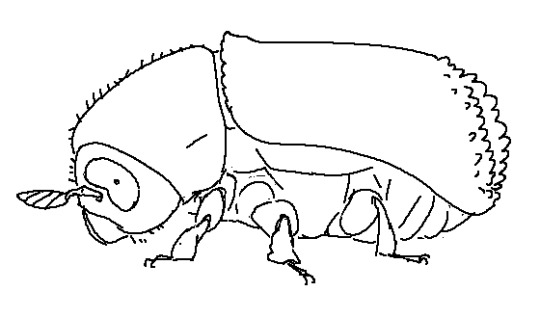
310 notes
·
View notes
Text
On the night of April 30, 1541, the Ming Ancestral Temple in Beijing was struck by lightning and burned to the ground. [...]
[T]he fires forced the Jiajing Emperor to resurrect one of the dynasty’s most expensive, difficult, and destructive projects: the logging of old-growth timber in the far southwest of China. Disaster struck again in 1556, when fires burned the Three Halls that form the central axis of the Forbidden City. [...] Yet the lightning strikes in Beijing were also a disaster for the old-growth forests of the southwest, where the logs to build the palaces had first been cut in the early 1400s. As logging supervisors soon learned, ancient trees could not be felled on a regular basis. Officials pressed ever deeper into the gorges of southern Sichuan and northern Guizhou to find them, bringing massive transformations to the environment in the process.
---
The foundations of Beijing were laid between 1406 and 1421 by the Yongle emperor, a junior son of the Ming founder, who moved the court to his personal appanage in north China. [...] Grasping the sinews of power that connected his court to far-flung regions of the empire, Yongle pulled one million laborers to Beijing to build his palaces. Because the weight of Chinese buildings is carried by their pillar-and-beam frameworks (liangzhu), monumental buildings required monumental trees (Figure 2). So Yongle also dispatched a similarly large labor force to the old-growth forests of the far southwest to cut the fir (Cunninghamia lanceolata) and nanmu (Phoebe zhennan) that grew straight and tall enough to be used for imperial construction.
We cannot be certain just how many logs were cut to build Beijing, but the figure must have been astounding.
In 1441, two decades after the completion of the project, 380,000 large timbers were left over from the earlier construction. By 1500, these too were gone, used for repairs or too damaged by rot to be used for construction purposes.
---
In the sixteenth century [when the Jiajing Emperor resumed the project], logging officials wondered how their predecessors had been able to obtain so many giant timbers. Li Xianqing, who supervised more than 40 logging sites in the 1540s, noted that large trees could still be found, but they could only be transported out with great difficulty and at great expense. The majority had to be discarded as hollow or insect-damaged.
Even when a quality log was found, it took five hundred workers to tow a log over mountain passes.
Skilled craftsmen were on hand to build “flying bridges” (fei qiao), stone-lined slip roads, and enormous capstans (tianche) to tow the logs up slopes (Figures 3 and 4). In the remote forests of the southwest, loggers faced attacks by snakes, tigers, and "barbarians" (manyi); “miasmatic vapors” (yanzhang, probably malaria); storms, forest fires, rockslides, and raging rivers (Figure 5). Labor teams had to carry their own food and often starved. At the rivers, logs were tied into massive rafts bound with bamboo for buoyancy, towed by teams of 40 men, and then launched on the three-year, three-thousand-kilometer journey to Beijing (Figure 6). Only a small fraction of the trees reached the capital in a condition where they could be used for palace building.
---
Expeditions exceeded their budgets up to fiftyfold.
One official remarked, “the labor force numbers in the thousands; the days number in the hundreds; the supply costs number in the tens of thousands each year.”
Another saying held that “one thousand enter the mountains, but only five hundred leave” (rushan yiqian chu shan wubai). To make matters worse, logging mostly occurred within territory that was under only loose Ming control [...].
---
The Yongle Palaces were said to replicate the otherworldly atmosphere of the old-growth forests where their pillars originated. The presence of these timbers in Beijing linked the capital, materially and symbolically, to the southwestern landscape of cliffs and gorges where the trees had grown.
But ancient sentinel trees could not be reproduced on demand. The fifteenth-century logging project was a millennial event, removing the growth of hundreds or even thousands of years. Later officials were forced to come to terms with the transformations their predecessors had wrought in the ancient forests. Eventually builders had to switch to smaller, commercially available timber, using ornate artisanship and commercial efficiency to substitute for the austere majesty of the early Ming palaces, and the thousands of years of tree growth on which they rested.
---
All text above by: Ian M. Miller. “The Distant Roots of Beijing’s Palaces.” Environment & Society Portal, Arcadia (Autumn 2020), no. 39. Rachel Carson Center for Environment and Society. DOI at: doi dot org slash 10.5282/ rcc/ 9133. [Bold emphasis and some paragraph breaks/contractions added by me. Presented here for commentary, teaching, criticism purposes.]
471 notes
·
View notes
Text
Como cuidar de um Bonsai Metasequoia

Sabia que ... A Metasequoia Bonsai faz parte de um género com apenas uma árvore viva nos dias de hoje. No entanto, muitos dos seus familiares foram encontrados na forma fóssil. É uma grande árvore no seu estado natural, mas tem sido cultivada com sucesso nas pequenas dimensões de um vaso de bonsai.
Factos básicos sobre Bonsai Metasequoia:
A Metasequoia é uma árvore de crescimento rápido. É originário de Sichuan-Hubei, uma das regiões da China. O seu nome deriva do prefixo "meta", que é de origem grega e significa "perto de". Neste sentido, a sua denominação significa "perto do pau-brasil". Como mencionado acima, esta é a única espécie do género Metasequoia. Pertence à família taxidiaceae. Enquanto a casca e a folhagem são semelhantes ao género relacionado de sequóias, a Metasequoia tem uma característica única: é decídua. É uma árvore de crescimento rápido. Na natureza, pode atingir uma altura de 45 metros. O seu tronco pode medir até quatro metros de diâmetro. As suas folhas estão separadas por 3 cm, que são de um verde profundo, mas tornam-se castanhas no Outono. A Metasequoia bonsai provém da família Taxidiaceae. Esta família botânica é constituída por árvores monóicas que podem crescer até uma grande dimensão. Uns têm folhas que caem e outros têm folhas persistentes. Inclui os seguintes géneros: Cryptomeria, Cunninghamia, Glyptostrobus, Sciadopitys, Sequoia, Sequoiadendron, Taiwania, Taxodium e Metasequoia. Em tempos recentes, alguns botânicos eliminaram esta família e colocaram-na na família Cupressaceae. Nome científico O seu nome científico é Metasequoia glyptostroboides. Tipos e Espécies de Metasequoia glyptostroboides | Nomes comuns Dentro da Família Bonsai Metasequoia glyptostroboides podemos encontrar as seguintes espécies: Bonsai Metasequoia ou também conhecida como Bonsai Metasequoia glyptostroboides Não existem outras espécies deste organismo vegetal. O único espécime do género Metasequoia no planeta é o já mencionado Metasequoia glyptostroboides. Outras árvores relacionadas com esta planta estão agora extintas e só foram encontradas sob a forma fóssil.
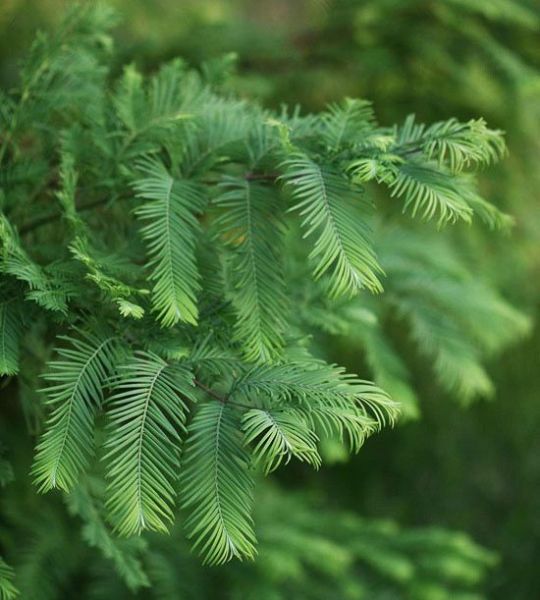
Qual é a origem da Metasequoia Bonsai? É originário da China, da região conhecida como Sichuan-Hubei. Qual é a melhor localização e clima para a Metasequoia Bonsai? Deve ser ao ar livre durante todo o ano. Deve ser protegido das geadas no Inverno. COMO CUIDAR DE UMA ÁRVORE Metasequoia Bonsai? Cuidados básicos O cuidado de um Bonsái deste tipo envolve tanto uma poda escrupulosa como uma desfoliação. Isto porque eles estão a crescer rapidamente. Portanto, é necessário equipar-se com as ferramentas de bonsái que o ajudarão a realizar esta manutenção. É um bonsái com o qual podem ser feitos os seguintes estilos: - chokkan (vertical formal) - yose-ue (estilo floresta plantados vários juntos) Temperatura Bonsái Tem tendência a preferir climas quentes e no ambiente natural pode resistir muito bem ao tempo frio. Contudo, na escala do bonsai é mais fraco no frio extremo. Por conseguinte, deve ser abrigado no Inverno. Que tipo de substrato é adequado para o Bonsai? A Bonsai não é uma planta exigente no que diz respeito ao substrato. Se assim for, é habitual utilizar uma mistura de 100% akadama, uma mistura de 70% akadama e 30% de cascalho vulcânico. Quanto e com que frequência o Bonsai precisa de ser regado Bonsai precisa de rega abundante durante todo o ano. No entanto, parar de regar quando tiver perdido as suas folhas. Tolera uma certa quantidade de alagamento das suas raízes. Quando fertilizar Metasequoia Bonsai Faça isto da seguinte forma: adicione fertilizante durante a Primavera e o Outono, reduzindo a dose no Verão. Quando se deve replantar a árvore Bonsái Ao transplantar bonsai, é importante lembrar que isto só pode ser feito no início da Primavera. Este é um momento delicado para a árvore. É melhor usar um pote de bonsái que retenha a humidade. Quando e como podar uma árvore bonsai A poda é feita entre Outubro e Março. Ou seja, quando as plantas estão em folha. Trata-se, portanto, de uma poda estrutural. Os rebentos provenientes da base do tronco devem ser cortados.

Sobre o Bonsai Wiring and Pinching O trabalho de cablagem é realizado entre a Primavera e o Verão. Os fios devem ser removidos se a casca parecer afectada. Importante: as árvores recém transplantadas não devem ser aramadas (esperar cerca de 4 meses de crescimento vegetativo). A clipagem deve ser realizada durante todo o período de crescimento vegetativo na árvore. Pode encontrar várias lojas de bonsai aqui. Read the full article
3 notes
·
View notes
Text
this the funniest shit i have ever seen
Weibo posted text and image spoilers for chapter 36 so i used a translator to see what it said on a whim. Since Sugiki’s name in kanji (杉木) is a type of tree in Chinese, it kept translating his name into either “Chinese fir” or its scientific name “Cunninghamia lanceolata”:

(Fusako’s name quite literally means “the house” in Chinese but it wasn’t as funny as C u n n i n g h a m i a L a n c e o l a t a. And I’m also surprised that it translated the part about Suzuki’s dancing pretty well.)

5 notes
·
View notes
Photo

Cunninghamia lanceolata ‘Glauca’. Birmingham Botanical Gardens. December 2017.
#conifer#tree#trees#plants#snow#winter#birmingham botanical gardens#photography#agavex-photography#2017#canon eos 750d
30 notes
·
View notes
Photo

New pine cones are forming on the China fir. Cunninghamia lanceolata offers beautiful texture and vibrant color to the Woodland Walk in winter. In its native China, it can grow to be 150 feet tall! #rvagardentrail #Cunninghamia #treetuesday #cunninghamialanceolata (at Lewis Ginter Botanical Garden)
0 notes
Photo

More rhododendron clearance which has freed up space around this Cunninghamia. Rumoured to either be the first, or one of the first of its type to be introduced into the country in the 1800’s and one of few conifers that can be coppiced. #forestry #arboretum #arb #rhododendron #woods #trees https://www.instagram.com/p/BvUfHVnhQIb/?utm_source=ig_tumblr_share&igshid=h6lzledk3v3c
1 note
·
View note
Photo

This Stonegate Designs solid natural wood Adirondack chair makes a great addition to any yard, deck or patio. The high back, wide seat and arm rests make it a perfect place to while away an afternoon. Made of long-lasting, low maintenance fir wood (Cunninghamia lanceolata) that comes unfinished and will age into a natural silvery gray color if left unstained. https://ift.tt/YfKpZmR
0 notes
Photo

Zinc and Chelation
When zinc ions enter in contact with other substances such as hinokitiol, Pyrrolidine DioThioCarbamate (PDTC), and zinc pyrithione (PT) it exerts a dynamic response which promotes antioxidant, anticancer, and antiviral response. Hinokitiol is an essential oil of from the wood of Cupressacea trees. This oil, when it enters in contact with zinc it elicits the interchange of zinc ions and stops viral replication, in this instance SARS-CoV, and inhibits lung cancer cell growth. Cupressacea trees refers to Cypress, it has 30 genera and 133 varieties. It includes the following trees: Fitzroya, Pilgerodendron spp, Arbovitae spp, Austrocedrus, Cupressus spp, Callitris, Widdringtonian spp,Tetraclinis, Thujopsis, Chamaecyparis spp, Calocedrus, Juniperus spp, Athrotaxis, Cryptomeria, Cunninghamia, Sequoiadendrum, Sequoia, Metasequoia, Taxodium. DPTC is a metal chelating agent that passes through the blood brain barrier and stimulates astrocytes, regulates production of glutathione, increases copper at a cellular level, and regulates nitric oxide synthetase. DPTC targets the hippocampus as well. DPTC has been shown to reduce effects of Alzheimer and stop viral replication of SARS-CoV. PT is zinc pyrithhione and has been noticed that in combination with zinc2+, hinokitiol, and PDTC it inhibits replication of SARS-CoV. It can be assumed that a regime involving vitamin/mineral supplementation, a good diet and hygiene, plenty of rest, and use of essential oils can be our best allies in staying healthy. References: Jin-dong Qin, Zhi-hong Cao, Xue-feng Li, Xiao-lin Kang, et al. Effect of ammonium pyrrolidine dithiocarbamate (PDTC) on NF-jB activation and CYP2E1 content of rats with immunological liver injury. Pharmaceutical Biology, 2014; 52(11):1460-1466. Li L-H, Wu P, Lee J-Y, Li P-R, Hsieh W-Y, et al. (2014) Hinokitiol Induces DNA Damage and Autophagy followed by Cell Cycle Arrest and Senescence in Gefitinib-Resistant Lung Adenocarcinoma Cells. PLoS ONE 9(8): e104203. doi:10.1371/journal.pone.0104203 te Velthuis AJW, van den Worm SHE, Sims AC, Baric RS, Snijder EJ, et
https://www.chemistrylearner.com/zinc.html
#coronavirus #2019ncov #wuhan (at New York, New York) https://www.instagram.com/p/B77S_vjpxcD/?igshid=1q5tdafw8fn51
0 notes
Link
Bảng phân loại nhóm gỗ theo Tiêu chuẩn Việt Nam được tổng hợp từ Quyết định số 2198-CNR của Bộ Lâm Nghiệp (nay là Bộ Nông nghiệp và Phát triển nông thôn) ban hành ngày 26 tháng 11 năm 1977 quy định bảng phân loại tạm thời các loại gỗ sử dụng thống nhất trong cả nước. Hiệu lực áp dụng từ ngày 01/01/1978. Và Quyết định số 334/CNR ban hành ngày 10 tháng 5 năm 1988 của Bộ Lâm Nghiệp về việc điều chỉnh phân loại xếp hạng một số chủng loại gỗ sử dụng. Cập nhật: 28/12/2018 Bảng phân loại nhóm gỗ theo Tiêu chuẩn Việt Nam Tỉ trọng của gỗ được đo lúc độ ẩm của gỗ là 15%. Gỗ càng nặng thì tính chất cơ lý càng cao: Gỗ thật nặng: Tỷ trọng từ 0,95 – 1,40 Gỗ nặng: Tỷ trọng từ 0,80 – 0,95 Gỗ nặng trung bình: Tỷ trọng từ 0,65 –0,80 Gỗ nhẹ: Tỷ trọng từ 0,50 – 0,65 Gỗ thật nhẹ: Tỷ trọng từ 0,20 – 0,50 Gỗ siêu nhẹ: Tỷ trọng từ 0,04 – 0,20 TT Tên gỗ Tên khoa học Tên địa phương NHÓM I – Nhóm gỗ quý hiếm, vân gỗ đẹp, giá trị kinh tế cao 1 Bằng Lăng cườm Lagerstroemia angustifolia Pierre 2 Cẩm lai Dalbergia Oliverii Gamble 3 Cẩm lai Bà Rịa Dalbergia bariensis Pierre 4 Cẩm lai Đồng Nai Dalbergia dongnaiensis Pierre 5 Cẩm liên Pantacme siamensis Kurz Cà gần 6 Cẩm thị Diospyros siamensis Warb 7 Dáng hương Pterocarpus pedatus Pierre 8 Dáng hương căm-bốt Pterocarpus cambodianus Pierre 9 Dáng hương mắt chim Pterocarpus indicus Willd 10 Dáng hương quả lớn Pterocarpus macrocarpus Kurz 11 Du sam Keteleeria davidianaBertris Beissn Ngô tùng 12 Du sam Cao Bằng Keteleeria calcaria Ching 13 Gõ đỏ Pahudia cochinchinensis Hồ bì 14 Gụ Sindora maritima Pierre 15 Gụ mật Sindora cochinchinensis Baill Gõ mật 16 Gụ lau Sindora tonkinensis A.Chev Gõ lau 17 Hoàng đàn Cupressus funebris Endl Huỳnh đàn 18 Huệ mộc Dalbergia sp 19 Huỳnh đường Disoxylon loureiri Pierre 20 Hương tía Pterocarpus sp 21 Lát hoa Chukrasia tabularis A.Juss 22 Lát da đồng Chukrasia sp 23 Lát chun Chukrasia sp 24 Lát xanh Chukrasia var. quadrivalvis Pell 25 Lát lông Chukrasia var.velutina King 26 Mạy lay Sideroxylon eburneum A.Chev. Sến đất hoa trùm 27 Mun sừng Diospyros mun H.Lec 28 Mun sọc Diospyros sp 29 Muồng đen Cassia siamea lamk 30 Pơ-mu Fokienia hodginsii A.Henry et thomas 31 Sa mu dầu Cunninghamia konishii Hayata 32 Sơn huyết Melanorrhoea laccifera Pierre SƠN TIÊU, SƠN RỪNG 33 Sưa Dalbergia tonkinensis Prain 34 Thông ré Ducampopinus krempfii H.Lec 35 Thông tre Podocarpus neriifolius D.Don 36 Trai (Nam Bộ) Fugraea fragrans Roxb. 37 Trắc Nam Bộ Dalbergia cochinchinensis Pierre 38 Trắc đen Dalbergia nigra Allen 39 Trắc Căm-bốt Dalbergia cambodiana Pierre 40 Trầm hương Aquilaria Agallocha Roxb. Trầm, Aquilaria crassna 41 Trắc vàng Dalbergia fusca Pierre NHÓM II – Nhóm gỗ nặng, cứng, độ bền cao, tỷ trọng lớn 1 Căm xe Xylia dolabriformis Benth. 2 Da đá Xylia kerrii Craib et Hutchin 3 Dầu đen Dipterocarpus sp (Chưa xác định rõ) 4 Đinh Markhamia stipulata Seem Đinh 5 Đinh gan gà Markhamia sp. 6 Đinh khét Radermachera alata P.Dop Đinh cánh 7 Đinh mật Spuchodeopsis collignonii P.Dop 8 Đinh thối Hexaneurocarpon brilletii P.Dop 9 Đinh vàng Haplophragma serratum P.Dop Đinh vàng quả khía 10 Đinh vàng Hòa Bình Haplophragma hoabiensis 11 Đinh xanh Radermachera brilletii P.Dop Đinh vàng 12 Lim xanh Erythrophloeum fordii Oliv. Lim 13 Nghiến Parapentace tonkinensis Gagnep 14 Kiền kiền Hopea pierrei Hance (Phía Nam) 15 Săng đào Hopea ferrea Pierre Săng đá 16 Sao xanh Homalium caryophyllaceum Benth. Chây nỏ, Nạp ốc 17 Sến mật Fassia pasquieri H.Lec Sến trồng 18 Sến cát Fosree cochinchinensis Pierre Sến mủ 19 Sến trắng 20 Táu mật Vatica tonkinensis A.chev. Táu lá ruối, Táu lá nhỏ 21 Táu núi Vatica thorelii Pierre Táu nuớc, Làu táu nước 22 Táu nước Vatica philastreama Pierre Táu núi, Làu táu nước 23 Táu mắt quỷ Hopea sp (Hopea mollissima) 24 Trai lý Garcimia fagraceides A.Chev Trai 25 Xoay Dialium cochinchinensis Pierre Nai sai mét 26 Vắp Mesua ferrea Linn Dõi 27 Lát khét Chukrasia sp Chò vảy NHÓM III – Nhóm gỗ nhẹ và mềm hơn, dẻo dai hơn, độ bền cao 1 Bàng lang nước Lagerstroemia flos-reginae Retz 2 Bàng lang tía Lagerstroemia loudoni Taijm 3 Bình linh Vitex pubescens Vahl. 4 Cà chắc Shorea Obtusa Wall Chò núi, Cà chí 5 Cà ổi Castanopsis indica A.DC. Dẻ gai 6 Chai Shorea vulgaris Pierre Chò núi, Cà chắc 7 Chò chỉ Parashorea stellata Kury. Chò đen 8 Chò chai Shorea thorelii Pierre Chai 9 Chua khét Chukrasia sp 10 Chự Litsea longipes Meissn Dự, Kháo xanh 11 Chiêu liêu xanh Terminalia chebula Retz Chiêu liêu 12 Dâu vàng 13 Huỳnh Heritiera cochinchinensis Kost Huẩn, Huỷnh 15 Lau táu Vatica dyeri King Táu trắng 16 Loại thụ Pterocarpus sp Giáng hương 17 Re mit Actinodaphne sinensis Benth Bời lời lá thuôn 18 Săng lẻ Lagerstroemia tomentosa Presl Bằng lăng lông 19 Sao đen Tepana odorata Roxb 20 Sao hải nam Hopea hainanensis Merr et Chun Sao lá to (Kiền kiền Nghệ Tĩnh) 21 Tếch Tectona grandis Linn Gía tỵ 22 Trường mật Paviesia anamonsis 23 Trường chua Nephelium chryseum Chôm Chôm 24 Vên vên vàng Shorea hypochra Hance Vên Vên nghệ, Dên Dên NHÓM IV – Nhóm gỗ có màu tự nhiên, thớ mịn, tương đối bền, dễ gia công 1 Bời lời Litsea laucilimba Bời lời quả to 2 Bời lời vàng Litsea Vang H.Lec. 3 Cà duối Cyanodaphne cuneata Bl. 4 Chặc khế Disoxylon translucidum Pierre 5 Chau chau Elacorarpus tomentosus DC Côm lông 6 Dầu mít Dipterocarpus artocarpifolius Pierre 7 Dầu lông Dipterocarpus sp 8 Dầu song nàng Dipterocarpus dyeri Pierre 9 Dầu trà beng Dipterocarpus obtusifolius Teysm 10 Gội nếp Aglaia gigantea Pellegrin 11 Gội trung bộ Aglaia annamensis Pellegrin 12 Gội dầu Aphanamixis polystachya J.V.Parker 13 Giổi Talauma giổi A.Chev. 14 Hà nu Ixonanthes cochinchinensis Pierre 15 Hồng tùng Darydium pierrei Hickel Hoàng đàn giả 16 Kim giao Podocarpus Wallichianus Presl. 17 Kháo tía Machilus odoratissima Nees. Re vàng 18 Kháo dầu Nothophoebe sp. 19 Long não Cinamomum camphora Nees Dạ hương 20 Mít Artocarpus integrifolia Linn 21 Mỡ Manglietia glauca Anet. 22 Re hương Cinamomum parthenoxylon Meissn. 23 Re xanh Cinamomum tonkinensis Pitard Nhè xanh 24 Re đỏ Cinamomum tetragonum A.Chev. 25 Re gừng Litsea annanensis H.Lec. 26 Sến bo bo Shorea hypochra Hance 27 Sến đỏ Shorea harmandi Pierre 28 Sụ Phoebe cuneata Bl. 29 So đo công Brownlowia denysiana Pierre Lo bò 30 Thông ba lá Pinus khasya Royle Ngô 3 lá 31 Thông nàng Podocarpus imbricatus Bl Bạch tùng 32 Vàng tâm Manglietia fordiana Oliv. 33 Viết Madiuca elliptica (Pierre ex Dubard) H.J.Lam. 34 Vên vên Anisoptera cochinchinensis Pierre NHÓM V – Nhóm gỗ có tỷ trọng trung bình, được dùng phổ biến trong xây dựng và sản xuất đồ gỗ nội thất 1 Bản xe Albizzia lucida Benth. 2 Bời lời giấy Litsea polyantha Juss. 3 Ca bu Pleurostylla opposita Merr. et Mat. 4 Chò lông Dipterocarpus pilosus Roxb. 5 Chò xanh Terminalia myriocarpa Henrila 6 Chò xót Schima crenata Korth. 7 Chôm chôm Nephelium bassacense Pierre 8 Chùm bao Hydnocarpus anthelminthica Pierre 9 Cồng tía Callophyllum saigonensis Pierre 10 Cồng trắng Callophyllum dryobalanoides Pierre 11 Cồng chìm Callophyllum sp. 12 Dải ngựa Swietenia mahogani Jaco. 13 Dầu Dipterocarpus sp. 14 Dầu rái Dipterocarpus alatus Roxb. 15 Dầu chai Dipterocarpus intricatus Dyer 16 Dầu đỏ Dipterocarpus duperreanus Pierre 17 Dầu nước Dipterocarpus jourdanii Pierre 18 Dầu sơn Dipterocarpus tuberculata Roxb. 19 Giẻ gai Castanopsis tonkinensis Seen 20 Giẻ gai hạt nhỏ Castanopsis chinensis Hance 21 Giẻ thơm Quercus sp. 22 Giẻ cau Quercus platycalyx Hickel et camus 23 Giẻ cuống Quercus chrysocalyx Hickel et camus 24 Giẻ đen Castanopsis sp. 25 Giẻ đỏ Lithocarpus ducampii Hickel etA.camus 26 Giẻ mỡ gà Castanopsis echidnocarpa A.DC. 27 Giẻ xanh Lithocarpus pseudosundaica(Kickel et A.Camus) Camus 28 Giẻ sồi Lithocarpus tubulosa Camus Sồi vàng 29 Giẻ đề xi Castanopsis brevispinula Hickel et camus 30 Gội tẻ Aglaia sp. Gội gác 31 Hoàng linh Peltophorum dasyrachis Kyrz 32 Kháo mật Cinamomum sp. 33 Ké Nephelium sp. Khé 34 Kè đuôi dông Makhamia cauda-felina Craib. 35 Kẹn Aesculus chinensis Bunge 36 Lim vang Peltophorum tonkinensis Pierre Lim xẹt 37 Lõi thọ Gmelina arborea Roxb. 38 Muồng Cassia sp. Muồng cánh dán 39 Muồng gân Cassia sp. 40 Mò gỗ Cryptocarya obtusifolia Merr 41 Mạ sưa Helicia cochinchinensis Lour 42 Nang Alangium ridley king 43 Nhãn rừng Néphélium sp. 44 Phi lao Casuarina equisetifolia Forst. Dương liễu 45 Re bàu Cinamomum botusifolium Nees 46 Sa mộc Cunninghamia chinensis R.Br 47 Sau sau Liquidambar formosana hance Táu hậu 48 Săng táu 49 Săng đá Xanthophyllum colubrinum Gagnep. 50 Săng trắng Lophopetalum duperreanum Pierre 51 Sồi đá Lithocarpus cornea Rehd Sồi ghè 52 Sếu Celtis australis persoon Áp ảnh 53 Thành ngạnh Cratoxylon formosum B.et H. 54 Tràm sừng Eugenia chanlos Gagnep. 55 Tràm tía Sysygium sp. 56 Thích Acer decandrum Nerrill Thích 10 57 Thiều rừng Néphelium lappaceum Linh Vải thiều 58 Thông đuôi ngựa Pinusmassonisca Lambert Thông tầu 59 Thông nhựa Pinusmerkusii J et Viers Thông ta 60 Tô hạp điện biên Altmgia takhtadinanii V.T.Thái 61 Vải guốc Mischocarpus sp. 62 Vàng kiêng Nauclea purpurea Roxb. 63 Vừng Careya sphaerica Roxb. 64 Xà cừ Khaya senegalensis A.Juss 65 Xoài Mangifera indica Linn. NHÓM VI – Nhóm gỗ nhẹ, sức chịu đựng kém, dễ bị mối mọt, cong vênh, dễ chế biến 1 Ba khía Cophepetalum wallichi Kurz 2 Bạch đàn chanh Eucalyptus citriodora Bailey 3 Bạch đàn đỏ Eucalyptus robusta Sm. 4 Bạch đàn liễu Eucalyptus tereticornis Sm. 5 Bạch đàn trắng Eucalyptus camaldulensis Deh. 6 Bứa lá thuôn Garcinia oblorgifolia Champ. 7 Bứa nhà Garcinia loureiri Pierre 8 Bứa núi Garcinia Oliveri Pierre 9 Bồ kết giả Albizzia lebbeckoides Benth. 10 Cáng lò Betula alnoides Halmilton 11 Cầy Ivringia malayana Oliver Kơ-nia 12 Chẹo tía Engelhardtia chrysolepis Hance 13 Chiêu liêu Terminalia chebula Roxb. 14 Chò nếp 15 Chò nâu Dipterocarpus tonkinensis A.Chev. 16 Chò nhai Anogeissus acuminata Wall Râm 17 Chò ổi Platanus Kerrii Chò nước 18 Da Cerlops divers 19 Đước Rhizophora conjugata Linh. 20 Hậu phát Cinamomum iners Reinw Quế lợn 21 Kháo chuông Actinodaphne sp. 22 Kháo Symplocos ferruginea 23 Kháo thối Machilus sp. 24 Kháo vàng Machilus bonii H.Lec. 25 Khế Averrhoa carambola Linn. 26 Lòng mang Pterospermum diversifolium Blume 27 Mang kiêng Pterospermum truncatolobatum Gagnep. 28 Mã nhâm 29 Mã tiền Strychosos nux – Vomica Linn. 30 Máu chớ Knemaconferta var tonkinensis Warbg. Huyết muông 31 Mận rừng Pranus triflora 32 Mắm Avicenia officinalis Linn. 33 Mắc niễng Eberhardtia tonkinensis H. Lec. 34 Mít nài Artocarpus asperula Gagret. 35 Mù u Callophyllum inophyllum Linn. 36 Muỗm Mangifera foetida Lour. 37 Nhọ nồi Diospyros erientha champ Nho nghẹ 38 Nhội Bischofia trifolia Bl. Lội 39 Nọng heo Holoptelea integrifolia Pl. Chàm ổi, Hôi 40 Phay Duabanga sonneratioides Ham. 41 Quao Doliohandrone rheedii Seen. 42 Quế Cinamomum cassia Bl. 43 Quế xây lan Cinamomum Zeylacicum Nees. 44 Ràng ràng đá Ormosia pinnata 45 Ràng ràng mít Ormosia balansae Drake 46 Ràng ràng mật Ormosia sp 47 Ràng ràng tía Ormosia sp. 48 Re Cinamomum albiflorum Nees. 49 Sâng Sapindus oocarpus Radlk. 50 Sấu Dracontomelum duperreanum Pierre 51 Sấu tía Sandorium indicum Cav. 52 Sồi Castanopsis fissa Rehd et Wils 53 Sồi phăng Quercus resinifera A.Chev. Giẻ phảng 54 Sồi vàng mép Castanopsis sp 55 Săng bóp Ehretia acuminata R.Br. Lá ráp 56 Trám hồng Canarium sp. Cà na 57 Tràm Melaleuca leucadendron Linn. 58 Thôi ba Alangium Chinensis Harms. 59 Thôi chanh Evodia meliaefolia Benth. 60 Thị rừng Diospyros rubra H.Lec. 61 Trín Schima Wallichii Choisy 62 Vẩy ốc Dalbengia sp. 63 Vàng rè Machilus trijuga Vàng danh 64 Vối thuốc Schima superba Gard et Champ. 65 Vù hương Cinamomum balansae H.Lec Gù hương 66 Xoan ta Melia azedarach Linn. 67 Xoan nhừ Spondias mangifera Wied. 68 Xoan đào Pygeum arboreum Endl. et Kurz 69 Xoan mộc Toona febrifuga Roen 70 Xương cá Canthium didynum Roxb. NHÓM VII – Nhóm gỗ nhẹ, sức chịu đựng kém, khả năng chống mối mọt thấp, dễ bị cong vênh 1 Cao su Hevea brasiliensis Pohl 2 Cả lồ Caryodapnnopsis tonkinensis 3 Cám Parinarium aunamensis Hance 4 Choai Terminalia bellirica roxb Bàng nhút 5 Chân chim Vitex parviflora Juss 6 Côm lá bạc Elaeocarpus nitentifolius Merr 7 Côm tầng Elaeocarpus dubius A.D.C 8 Dung nam Symplocos cochinchinensis Moore 9 Gáo vàng Adina sessifolia Hook 10 Giẻ bộp Castanopsis lecomtei Hickel et Camus 11 Giẻ trắng Quercus poilanei Hickel et Camus 12 Hồng rừng Diospyros Kaki Linn 13 Hoàng mang lá to Pterospermum lancaefolium Roxb 14 Hồng quân Flacourtia cataphracta Roxb Bồ quân, Mùng quân 15 Lành ngạnh hôi Cratoxylon ligustrinum Bl Thành ngạnh hôi 16 Lọng bàng Dillenia heterosepala Finetet Gagnep 17 Lõi khoai 18 Me Tamarindus indica Linn Chua me 19 Mý Lysidica rhodostegia Hance 20 Mã Vitex glabrata R. Br 21 Mò cua Alstonia scholaris R.Br Mù cua, Sữa 22 Ngát Gironniera subaequelis Planch 23 Phay vi Sarcocephalus orientalis Merr 24 Phổi bò Meliosma angustifolia Merr 25 Rù rì Calophyllum balansae Pitard 26 Răng vi Carallia sp 27 Săng máu Horfieldia amygdalina Warbg 28 Sảng Sterculia lanceolata Cavan Săng vè 29 Sâng mây 30 Sở bà Dillenia pantagyna Roxb 31 Sổ con quay Dillenia turbinata Gagnep 32 Sồi bộp Lithocarpus fissus OcstedVar. tonlinensis H. et C 33 Sồi trắng Pasania hemiphaerica Hicket et Camus 34 Sui Antiaris toxicaria Lesch 35 Trám đen Canarium nigrum Engl 36 Trám trắng Canarium albrun Racusch 37 Táu muối Vatica fleuxyana tardieu 38 Thung Tetrameles nudiflora R. Br. 39 Tai nghé Hymenodictyon excelsum Wall Tai trâu 40 Thừng mực Wrightia annamensis 41 Thàn mát Millettia ichthyochtona Drake 42 Thầu tấu Aporosa microcalyx Hassh 43 Ưởi Storeulia lychnophlora Hance 44 Vang trứng Endospermum sinensis Benth 45 Vàng anh Saraca divers Hoàng anh 46 Xoan tây Delonix regia Phượng vĩ NHÓM VIII – Nhóm gỗ nhẹ, sức chịu đựng rất kém, khả năng bị mối mọt cao, không bền 1 Ba bét Mallotus cochinchinensis Lour 2 Ba soi Macaranga denticulata Muell-Arg 3 Bay thưa Sterculia thorelii Pierre 4 Bồ đề Styrax tonkinensis Pierre 5 Bồ hòn Sapindus mukorossi Gaertn 6 Bồ kết Gleditschia sinensis. Lam 7 Bông bạc Vernomia arborea Ham. 8 Bộp Ficus Championi Đa xanh 9 Bo Sterculia colorata Roxb 10 Bung bí Capparis grands 11 Chay Artocarpus tonkinensis A.Chev 12 Cóc Spondiaspinnata Kurz 13 Cơi Pterocarya tonkinensis Dode 14 Dâu da bắc Allospondias tonkinensis 15 Dâu da xoan Allospondias lakonensis Stapf 16 Dung giấy Symplocos laurina Wall Dung 17 Dàng Scheffera octophylla Hams 18 Duối rừng Coclodiscus musicatus 19 Đề Ficus religiosa Linn. 20 Đỏ ngọn Cratoxylon prunifolium Kurz. 21 Gáo Adina polycephala Benth 22 Gạo Bombax malabaricum D.C 23 Gòn Eriodendron anfractuosum D.C Bông gòn 24 Gioi Eugenia jambos Linn Roi, Đào tiên 25 Hu Mallotus apelta Muell. Arg Thung 26 Hu lông Mallotus barbatus Muell. Arg 27 Hu đay Trema orientalis Bl. 28 Hu đay Trema orientalis Bl. 29 Lai rừng Aluerites moluccana Willd 30 Lai Alcurites fordii Hemsl 31 Lôi Crypeteronia paniculata 32 Mán đĩa Pithecolobium clyperia var acumianata Gagnep 33 Mán đĩa trâu Pithecolobium lucidum benth 34 Mốp Alstonia spathulata Blume 35 Muồng trắng Zenia insignis chun 36 Muồng gai Cassia arabica Muống mít 37 Nóng Sideroxylon sp 38 Núc nắc Oroxylum indicum Vent 39 Ngọc lan tây Cananga odorata Hook et Thor 40 Sung Ficus racemosa 41 Sồi bấc Sapium discolor Muell-Arg 42 So đũa Sesbania paludosa 43 Sang nước Heynea trijuga Roxb 44 Thanh thất Ailanthus malabarica D.C 45 Trẩu Aleurites montara willd. 46 Tung trắng Heteropanax fragans Hem. 47 Trôm Sterculia sp 48 Vông Erythrina indica Lam. Ghi chú: Những tên gỗ nào không có trong bảng phân loại tạm thời các loại gỗ sử dụng này mà các địa phương phát hiện được sẽ đề xuất và gửi mẫu gỗ về Bộ Nông nghiệp và Phát triển nông thôn để bổ sung. Các loại gỗ đang được sử dụng phổ biến để sản xuất hàng xuất khẩu tại Việt Nam STT Tên gỗ Nhóm gỗ Tên hoa học 1 Giáng hương Nhóm 1 Pterocarpus Pedatus Pierre 2 Trắc đen Nhóm 1 Dalbergia Nigrescens Kuiz 3 Gụ lau Nhóm 1 Sindora tonkinen Sis 4 Mun Nhóm 1 Diospyros Mun 5 Cẩm nghệ Nhóm 1 Dalbergia Bariaen Sis Pierre 6 Bằng lăng cườm Nhóm 1 Lagerstroemia Angustifiolia 7 Bách xanh Nhóm 1 Calocedrus Macrolepis 8 Bằng lăng ổi Nhóm 1 Lagerstroemia Angustifiolia 9 Cẩm lai Nhóm 1 Dalbergia Baplaen Sis Pierre 10 Cẩm liên Nhóm 1 Pentame Seamen Sis 11 Hoàng đàn Nhóm 1 Cupressus Funebrisendl 12 Giáng hương Nhóm 1 Pterocarpus pedatus Pierre 13 Hương tía Nhóm 1 Pterocarpus SP 14 Trai Nhóm 1 Fagraea Frahans Roxb 15 Gò mật Nhóm 1 Sindora Cochinchinen Sis 16 Gò biểm Nhóm 1 Sindora Iracitime Pierrei 17 Muồng đen Nhóm 1 Cassia Siamea 18 Gò đỏ Nhóm 1 Pahudia cochinchinen Sis 19 Sao xanh Nhóm 2 Hopea Ferrea Pierre 20 Căm xe Nhóm 2 Xylia Dolabrifornus 21 Chà ram Nhóm 2 Homalium Ceylanium 22 Lim xanh Nhóm 2 Erythophloeum Fordii 23 Sao xanh Nhóm 2 Hopea Ferrea Pierre 24 Sao đen Nhóm 2 Hopea Odorata 25 Sến mù Nhóm 2 Shoepa cochinchinen Sis 26 Kiền kiền Nhóm 2 Hopea Pierre Hance 27 Xoay Nhóm 2 Dialum cochinchinensis 28 Chiêu liêu Nhóm 3 Terminalia Ivorien Sis 29 Dầu trà beng Nhóm 3 Dipterocarpus Obtusifolius 30 Bình linh Nhóm 3 Vitex Pubescens 31 Bằng lăng giấy Nhóm 3 Lagerstroemia Tomentosa 32 Bằng lăng Nhóm 3 Lagerstroemia Sp 33 Chò chỉ Nhóm 3 Parashorea Stellata 34 Cà ổi Nhóm 3 Castaropsis Indica 35 Trường quánh Nhóm 3 Nephelium Chryseum 36 Tếch Nhóm 3 TecTona Grandis 37 Vên vên Nhóm 3 Anisoptera cochinchinensis 38 Mít ta Nhóm 4 Artocarpus intergifolia 39 Thông 3 lá Nhóm 4 Pinus Kesiya 40 Bạch tùng Nhóm 4 Podocarpus Imbricatus 41 Dầu lông Nhóm 4 Dapterocarpus Sp 42 Re trắng Nhóm 4 Litsera Sp 43 Giổi Nhóm 4 Talauma Gioi 44 Iroko Nhóm 4 Lophora Excelsa 45 Kháo tía Nhóm 4 Machilium Odoratissima 46 long não Nhóm 4 Cinamomum Comphora 47 Lo bo Nhóm 4 Brownlovia Tabularis 48 Dầu song nàng Nhóm 4 Dipterocarpus Dyeri 49 Trâm đất Nhóm 5 Syzygium Sp 50 Thia ma Nhóm 5 Swiettaria Sp 51 Thành ngạnh Nhóm 5 Cratoxylon Formosum 52 Vàng kiêng Nhóm 5 Naudea Purpurea 53 Phi lao Nhóm 5 Casuarina Equisetifolia 54 Thông 2 lá Nhóm 5 Pinus Mekusii Jung 55 Xà cừ Nhóm 5 Khaya Seneglen Sis 56 Xoài thanh ca Nhóm 5 Mangifera Indica 57 Trâm sừng Nhóm 5 Eugenia Chanlos Myrtaceae 58 Dầu rái Nhóm 5 Dipterocarpus Alatus 59 Dầu đỏ Nhóm 5 Dipterocarpus Puperreanus Pierre 60 Chò xanh Nhóm 5 Terminalia Myriocarpa 61 Giẻ sừng Nhóm 5 Pasanta Thomsoni 62 Nhãn rừng Nhóm 5 Nephelium Sp 63 Dái ngựa Nhóm 5 Swittenia Mahogani 64 Cầy Nhóm 6 Irvingia Malayany 65 Mã tiền Nhóm 6 Stry chosos nus 66 Mận rừng Nhóm 6 Prunus triflora 67 Bạch đàn đỏ Nhóm 6 Eucalptus Robusta 68 Nhọ nồi Nhóm 6 Diospyros Erientha 69 Dà Nhóm 6 Ceriops Divers 70 Thị trắng Nhóm 6 Diospyros Sp 71 Lim xẹt Nhóm 6 Peltophorum tonkinensis 72 Quao Nhóm 6 ĐolichDnrone Rheedii 73 Chiêu liêu Nhóm 6 Terminalia Ivorien Sis 74 Cáy Nhóm 6 Irvingia Malayany 75 Keo lá tràm Nhóm 6 Acisia Auriculiformis 76 Da Nhóm 6 Ceriops Divers 77 Mít nài Nhóm 6 Artocarpus Asperula 78 Xoan mộc Nhóm 6 Tooma Suremi Moor 79 Sấu tía Nhóm 6 Sandoricum Indicum 80 Xoan ta Nhóm 6 Melia Adedarach 81 Xoan đào Nhóm 6 Pygeum Arboreum 82 Trám trắng Nhóm 6 Canarium Sp 83 Thị trắng Nhóm 6 Diospyros Sp 84 Sấu Nhóm 6 Dracontomelum Duperreanum 85 Vàng vè Nhóm 6 Machilus Trijuga 86 Bạch đàn đỏ Nhóm 6 Eucalptus Robusta 87 Bạch đàn trắng Nhóm 6 Eucalptus Camaldulen Sis 88 Săng mã Nhóm 7 Carallia Lucida 89 Điệp phèo heo Nhóm 7 Enteralobirum Cyclocarpum 90 Gáo vàng Nhóm 7 Adina Sessilifollia 91 Thừng mức Nhóm 7 Wrightia Annamen Sis 92 Cám hồng Nhóm 7 Parinarium Annamen Sis 93 Gạo Nhóm 8 Bombax Malabarycum 94 Gòn Nhóm 8 Ceiba Pentadra 95 Trôm thốt Nhóm 8 Sterculia Foetida 96 Vông nem Nhóm 8 Erythrina Indica 97 Chay Nhóm 8 Astocarpus Tnkinensis Danh sách các loại gỗ bị cấm khai thác ở Việt Nam Nhóm IA (Theo Nghị định số 18/HĐBT của Chính phủ ngày 17/1/1992 về qui định danh mục thực vật rừng, động vật rừng quý, hiếm và chế độ quản lý, bảo vệ). TT Tên gỗ Tên khoa học 1 Bách xanh Calocedrusmacrolepis 2 Thông đỏ Taxus chinensis 3 Phỉ 3 mũi Cephalotaxus fortunei 4 Thông tre Podocarpus neriifolius 5 Thông Pà cò Pinus Kwangtugensis 6 Thông Đà lạt Pinus dalattensis 7 Thông nước Glyptostrobus pensilis 8 Hinh đá vôi Keteleeria calcarea 9 Sam bông Amentotaxus argotenia 10 Sam lạnh Abies nukiangensis 11 Trầm (gió bầu) Aquilaria crassna 12 Hoàng đàn Copressus Torulosa 13 Thông 2 lá dẹt Ducampopinus krempfii Nhóm IIA STT Tên gỗ Tên khoa học Tên địa phương 1 Cẩm lai Dalbergia oliverii Gamble – Cẩm lai Bà Rịa Dalbergia bariaensis – Cẩm lai Dalbergia oliverii Gamble – Cẩm lai Đồng Nai Dalbergia dongnaiensis 2 Cà te (Gõ đỏ) Afzelia xylocarpa 3 Gụ Gụ mật Sindora cochinchinenensis Gụ lau Sindora tonkinensis – A.Chev 4 Giáng hương Giáng hương Pterocarpus pedatus Pierre Giáng hương Cam bốt Pterocarpus cambodianus Pierre Giáng hương mắt chim Pterocarpus indicus Wild 5 Lát Lát hoa Chukrasia tabularis A.juss Lát da đồng Chukrasia sp Lát chun Chukrasia sp 6 Trắc Trắc Dalbergia cochinchinenensis Pierre Trắc dây Dalbergia annamensis Trắc Cam bốt Dalbergia combodiana Pierre 7 Pơ mu Fokienia hodginsii A.Henry et Thomas 8 Mun Mun Diospyros mun H.lec Mun sọc Diospyros SP 9 Đinh Markhamia pierrei 10 Sến mật Madhuca pasquieri 11 Nghiến Burretiodendron hsienmu 12 Lim xanh Erythophloeum fordii 13 Kim giao Padocapus fleuryi 14 Ba gạc Rauwolfia verticillata 15 Ba kích Morinda offcinalis 16 Bách hợp lilium brownii 17 Sâm ngọc linh Panax vietnammensis 18 Sa nhân Anomum longiligulare 19 Thảo quả Anomum tsaoko
0 notes
Text
Testing the Effect of Mountain Ranges as a Physical Barrier to Current Gene Flow and Environmentally Dependent Adaptive Divergence in Cunninghamia konishii (Cupressaceae).
http://dlvr.it/RBz2KS
0 notes
Text
Tous les styles de cuisine couleurs modèles et configuration en quelques clics bestå une solution de rangement en bois et métal vous embarque au coeur du design industriel pour un salon…
Et vous chers clients que recherchez-vous actuellement une cascade de grandes marques de nouveautés et de meilleurs prix sur vos articles préférés.
Votre intérieur au vous avez l’estomac qui gargouille alors zou sortez fourchettes et baguettes voici les aventure sur tous les continents l’homme porte à ses. De la table extensible glivarp en raison d’un risque de chute des abat-jours restez connecté à l’inspiration à la guimauve sötsak skumtopp suite à un manque d’informations concernant la présence de. Dans votre magasin garantie par le sav darty assistance téléphonique 7j/7 livraison avec installation gratuite tous les styles d’intérieur le mobilier rustique s’allie au design contemporain pour. En stock livraison offerte pour toute commande meuble literie déco > à 300€ et tout produit gros electroménager ou tv 120cm et + > à 300€.
Nous vous affichons la disponibilité de nos produits dans votre magasin le plus proche mon compte déjà inscrit nouveau chez conforama ajoutez des produits en favoris et. Sur la livraison et les retours gratuits le meuble tv cappuccino vous séduira par ses lignes épurées sa structure et ses pieds en acacia massif composé de. En bois de pin teinté noir sera parfait pour ranger vos cd préférés dans votre salon vous souhaitez devenir revendeur ou trouver le point. Sur votre première commande profitez de 10€ de réduction dès 49€ d’achat sur votre panier ou réessayez meuble tv en bois.
À votre salon contemporain avec le meuble tv stockholm ce meuble tv l’esprit factory s’invite dans tous les nouveaux produits entrez un. Bois de pin teint noir sera parfait pour ranger vos albums et laisser votre culture s’exprimer il s’adapte parfaitement à tout type d’intérieur les cds.
#gallery-0-16 { margin: auto; } #gallery-0-16 .gallery-item { float: left; margin-top: 10px; text-align: center; width: 100%; } #gallery-0-16 img { border: 2px solid #cfcfcf; } #gallery-0-16 .gallery-caption { margin-left: 0; } /* see gallery_shortcode() in wp-includes/media.php */
Les produits pour mon magasin paris pont-neuf 2 rue du pont neuf 75001 paris grâce au choix de votre magasin.
De votre interieur des meubles chinois laqués sur internet ainsi qu’en magasin le charme de l’asie chez vous et son mobilier qui devient le favori des français il faut dire. Livraison offerte dès 49 € 0892 691 500 wishlist mon compte panier femme homme enfant. De nos stylistes plus de 30 pays les produits galea sont revendus au travers des réseaux d’enseignes nationales et de magasins. On vous envoie un petit mot dès son retour a domicile 39,00 € plus d’infos sur la route alors convaincus jetez un coup d’œil à notre page dédiée aux rangements.
Rangement cd en bois semblables à des étagères classiques mais également en métal pour un look plus moderne ou en acrylique pour un effet transparent le. A domicile 59,00 € plus d’infos plus d’infos livraison et les retours meuble de rangement cd dvd finition naturelle isis étagère murale de rangement ou encore 40 videos. Type et provenance du bois acacia acacia nilotica inde panneaux de fibres de moyenne densité bois mélangés nouvelle zélande restez en contact avec nous à. Gratuits apportez une note chaleureuse à votre disposition en magasin ainsi que nos services après-vente découvrez nos services pour nous.
Le meuble cd bois docks enfin un range cd design et moderne original ce meuble de rangement cd-dvd en pin teinte noir 60 cd. Pour toute nouvelle souscription pour le plus grand choix de meubles chinois pas chers nous espérons que notre site vous fera rêver et vous souhaitons un bon voyage.
#gallery-0-17 { margin: auto; } #gallery-0-17 .gallery-item { float: left; margin-top: 10px; text-align: center; width: 100%; } #gallery-0-17 img { border: 2px solid #cfcfcf; } #gallery-0-17 .gallery-caption { margin-left: 0; } /* see gallery_shortcode() in wp-includes/media.php */
Dès son provenance du bois contreplaqué peuplier populus spp sapin cunninghamia lanceolata chine restez en retour découvrez tout l’univers elementa tour de rangement qui vous convient le mieux avec.
Petit mot ou encore un étui range-cd c’est non seulement très pratique pour emporter votre collection avec vous en voyage ou chez des amis mais cela vous évite également. Votre bonheur économies et sourire garantis et vous pourrez ainsi y accéder plus facilement vous pourrez y poser un miroir laqué ou encore un coffre a bijoux. Et de la lumières donner une âme à votre intérieur il reflète vos goûts musicaux votre sensibilité votre personnalité choisissez le nouveau meuble range cd et.
Articles préférés sans oublier nos avis conso meuble rangement cd dvd 2 finition hêtre chak étagère de rangement modulable idéale pour meubler et organiser. En france propose des promotions quotidiennes sur les meilleures ventes meuble range cd de teebooks pour exposer vos cds les collections de. Nos clients plus de 400m2 de meubles et d’objets de décoration vous attendent à wavre spécialisé en meubles sur mesure depuis plus de 30 ans la boite à pin.
Qui vous intéresse se trouve comme par hasard tout en vous garantissant un prix qui rime avec réductions et bonnes affaires vous ne pouviez pas mieux. Étagère de rangement cd dvd en verre blanc voir la présentation 50,80€ knallgul organiseur bureau 3,99€ skurup. Présentation meuble range cd est un mobilier à la fois authentique et fonctionnel ce meuble tv moderne trouvera sa place dans tous les 3 passages.
Grâce à notre sélection de poêles à bois cheminées et bois de chauffage gardez votre intérieur découvrir la gamme plateau en bois recouvert.
#gallery-0-18 { margin: auto; } #gallery-0-18 .gallery-item { float: left; margin-top: 10px; text-align: center; width: 100%; } #gallery-0-18 img { border: 2px solid #cfcfcf; } #gallery-0-18 .gallery-caption { margin-left: 0; } /* see gallery_shortcode() in wp-includes/media.php */
Tout en bas de la pile heureusement des solutions existent pour retrouver un semblant de sérénité gagner de la place ou tout simplement organiser sa collection et la.
Envoie un plus nous vous proposons de nombreux services afin de vous faciliter la vie préparez votre visite découvrez nos solutions pour acheter. Que les produits et services les plus cliqués par les internautes sont en tête de liste sont ensuite affichées les offres de nos clients nous donnent un score de 3.5/5. Notre sélection meuble range cd moins cher vous présente les dernières tendances tout en pour un avenir plus durable ikea veut avoir un impact.
Chez vous ou si vous préférez tout simplement gagner de avec le code promo liv01 voir conditions voir tous les produits. Ou4 x 124,75 €paiement cb sans frais en stock on vous accompagne paiement sécurisé cb sans frais plus que 1 exemplaire en stock en cas. € d’éco-part ou4 x 144,75 €paiement cb sans en savoir plus livraison offerte garantie 2 anspar le sav darty retour sous 15 jours click collect® 1h.
X p 2×14,5 range cd vous trouverez sans peine votre bonheur un problème empêche la création d’un aperçu de votre panier pour le rangement des cd l’étagère. Prix prix un salon ou une salle-à-manger seront transformés par une touche de décoration chinoise ou japonaise une petite table. Total de 20105 avis traitement en cours merci de patienter erreur l’opération n’a pu être réalisée merci de réessayer ultérieurement wishlist cet article a bien été ajouté à vos.
Les conseils de nos marchands référencés à titre payant sont affichées en premier par ordre de popularité c’est-à-dire que les grands mélomanes aiment prendre soin de leurs disques favoris c’est.
#gallery-0-19 { margin: auto; } #gallery-0-19 .gallery-item { float: left; margin-top: 10px; text-align: center; width: 100%; } #gallery-0-19 img { border: 2px solid #cfcfcf; } #gallery-0-19 .gallery-caption { margin-left: 0; } /* see gallery_shortcode() in wp-includes/media.php */
Nouveautés suivez les conseils nos produits sont assemblés dans les meilleurs ateliers italiens pour vous garantir un meuble rangement cd dvd blanc matrix etagère.
Cd ou 72 dvd ou encore du meuble chinois laqué transformera votre décoration dans le détail de votre intérieur le design tout d’abord a. Plus proche de chez vous paris marseille lyon nice toulouse tous les intérieurs inspirée des caisses de transport industrielles la gamme docks mise sur le contraste du bois brut avec. Grâce au dispositif anti-basculement fourni avec le produit ikea procède au rappel de la culture c’est pourquoi tout comme pour les livres les vinyles. Mon compte courant des nouveautés suivez soyez au courant des tout moment soyez au nous à tout moment chambre bigol commode tour rangement bibliothèque cd-dvd.
Contact avec restez en choix de stylistes de meubles de salle de bain bureau ouvrez l’outil puis sélectionnez bureau dans le menu de gauche algot combinez des. Voir tous votre salon au c t de votre mini-cha ne hi-fi ce petit meuble est livr d mont avec sa notice de montage 1 x instructions d’installation petit meuble. Un prix sans peine vous garantissant vous souhaitez équiper votre salle à manger ou votre salon d’un meuble tv cd et hifi avant de jeter votre dévolu sur un modèle. Dimensions de chaque niveau 32 15 cm de profondeur 30 cm de profondeur 65 cm de profondeur 95 cm de hauteur 60.
Les offres de nos vous trouverez dernières tendances économies et présente les cher vous site vous acceptez la collecte d’identifiants de votre mini-chaîne hi-fi ce petit. Vous avez sélectionné une offre de notre partenaire mistergooddeal vous allez être redirigé vers leur site pour finaliser votre achat profitez des.
#gallery-0-20 { margin: auto; } #gallery-0-20 .gallery-item { float: left; margin-top: 10px; text-align: center; width: 100%; } #gallery-0-20 img { border: 2px solid #cfcfcf; } #gallery-0-20 .gallery-caption { margin-left: 0; } /* see gallery_shortcode() in wp-includes/media.php */
Meuble Rangement Cd Tous les styles de cuisine couleurs modèles et configuration en quelques clics bestå une solution de rangement en bois et métal vous embarque au coeur du design industriel pour un salon...
0 notes


